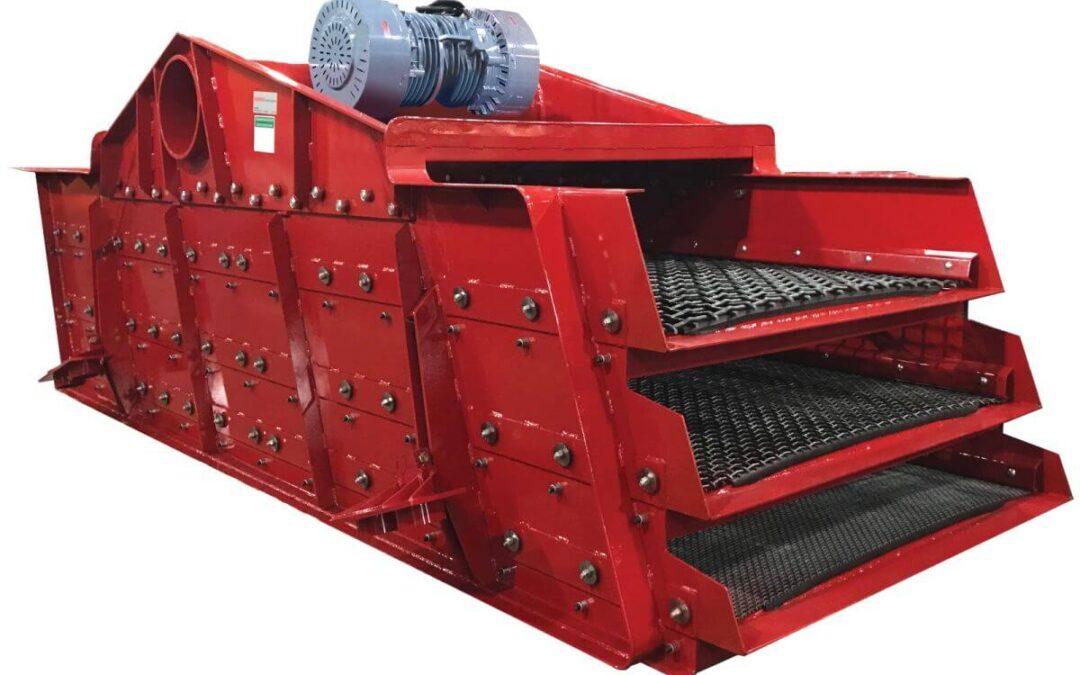It’s widely known that vibrating feeders are a crucial part of the industrial screening process. The solid waste management, recycling, and aggregate industries all have access to a variety of material handling systems; however, vibrating screens offer a number of distinct features that make them a go-to choice for a wide range of industrial applications.
Read the blog to learn how vibrating screens function and the advantages they offer over other typical forms of screening equipment.
WHAT IS A VIBRATING SCREEN & WHAT ARE ITS USES?
When it comes to the machinery used in factories, vibratory screeners play a crucial role in providing mechanical solutions to problems. They offer a wide variety of distinct benefits, which places them at the forefront of the handling systems for the most important industrial uses. The basic concept behind vibrating screen design is the transmission of vibrations to a screening surface in order to effect a separation. The chassis of a screen is its primary component, and it provides support for the various surfaces that make up the screen.
The screen can tell the difference between dust and other particles by analyzing their size, shape, and density. To begin, raw bulk material is transported forward from the intake. The vibrating feeders are loaded in the middle, allowing the material to rotate radially across the outer edges. As the most well-known piece of machinery in the waste management, recycling, and aggregate industries, it provides a variety of beneficial outcomes.
Putting more emphasis on the machine’s principle, the vibrations break down the particles, forcing them to separate into fine crumbles. This separation process is enhanced since the small particles can easily pass through the screen’s perforated surface. The larger particles are carried over the screen surface in front of you. Vibrating feeders utilize this property in a wide variety of industrial settings, most notably in the mineral processing and recycling industries.
WORKING PRINCIPLE OF VIBRATING SCREENS
All screens are built with holes of varying sizes to facilitate their primary function: the separation of materials by particle size. Crushing facilities employ vibratory screeners to sort the stones into various sizes according to the final product’s specifications.
The pebble must be small enough to fit through the hole in the vibrating feeder and fall into the space below the screen. The screen-size-insufficient rock was able to pass through. Modern vibrating screens typically have several tiers. Each level has its own set of screens, which are carried on decks. Materials that are too large to pass through the material handling system at the end of a layer are dropped to the layer below; otherwise, they are released from the system at the end of the layer where the screen is positioned. At last, the product outlets distribute the ingredients from each layer independently. So, the rocks are categorized according to their sizes.
TYPES OF VIBRATING SCREEN
Various vibratory screeners are available on the market, each with their own unique design, operating principle, and screen material. The angle of the screen deck can be used to categorize it into two distinct subsets.
Inclined Screen:
The inclination rate of the screen can typically be adjusted between 15 and 30 degrees. Slanted screens’ eccentric loads will differ due to the low stroke and increased weight of the sloped screen.
Horizontal Screen:
The horizontal screen moves in an ellipse pattern and is perpendicular to the ground. The screening system’s effectiveness improves as the holes get larger, allowing for better collection of particles at the appropriate size.
APPLICATIONS OF VIBRATING SCREENS
Vibratory screeners are used in a wide range of industries. Some of them are:
- Food Industry
- Oil Industry
- Agro Products Manufacturing Industry
- Pharmaceuticals
- Chemical Industry
- Mineral Processing Plants
- Mining
- Rubber Industry
- Paper Industry
- Sugar Industry
FEATURES OF VIBRATING SCREENS
Vibrating screens are significantly more effective than conventional screens:
Non-vibrating screens typically use a fixed mesh that is steeply inclined. On vibrating, the product shakes and the particles jump without sliding on the screening surface. Each jump is an effort to squeeze through the opening, and the odds favor the particle if the machine is vibrating. That is to say, the efficacy is dramatically increased.
In the event of a particle’s repeated jumping and falling, it can land either in a hole or in a region devoid of holes. A particle that falls on a wire or another particle instead of through a hole in a wire mesh screening element will not pass through the hole. This is because all the tiny particles that the holes actually leak would need to make an infinite number of hops, making it impossible for any screen to have 100% efficiency.
The effectiveness of a handling system can be calculated by dividing the mass of particles that pass through the screen by the mass of particles that should pass through the screen.
Manufacturing capability of vibrating screens:
More screening area is required for sorting a larger volume of goods. The most noticeable sign that a screen’s holes have become too small is that it is becoming less effective. However, the surface area required increases with the decreasing size of the object to be categorized since fewer items will fit through the holes.
Frequency of vibration in vibrating screens:
When classifying broadly, low frequencies and big vibration amplitudes are preferred, but when classifying narrowly, high frequencies and small amplitudes are preferred. Therefore, if the particle is large, it is preferable for it to move slowly and widely, making fewer, larger jumps, while if the particle is small, it is preferable for it to move quickly and narrowly, making numerous, smaller jumps. The particle needs to avoid going through many single-jump holes.
The Importance of Proper Feeding
The vibrating feeders, like any other sorting machine, require the use of the full available work area, commencing at the far left. The particles at the top of a pile that forms when product falls onto a screening surface will not contact the mesh or the screening element until the pile dissipates due to vibration. It will have traveled halfway to the surface by the time this occurs. What this means is that not only do we incur significant maintenance costs due to increased wear on the area where the pile is produced, but we also waste valuable surface space. It also raises the potential for jams if the pile gets too tall, which is especially problematic for low-density items. The ducts used to pour the product onto the screen must be carefully implemented and designed, with auxiliary means such as vibrating distributors used if necessary.
There are both good and bad screens:
The more a vibratory screener vibrates, the better it goes; in other words, the more it vibrates, the more production and efficiency it will provide. A good vibrating screen will have these qualities and more.
Most supposedly “bad” screens, however, are simply inappropriate: Screening with polyurethane may not be an option if the product is sticky and damp. The vibrating feeder should be dust-proof if the dust is dry and fine. Screening for large and heavy particles requires a sturdy device. The electricity and maintenance expenses will be higher than necessary if it is highly sturdy and used with high-quality materials, but this shouldn’t be an issue as utility companies for businesses may be compared at Energy Saving Expert.
BENEFITS OF VIBRATING SCREENS
- Lower Operating Expenses: Vibrating screens are well-known for their sturdy construction, easy working concept, and streamlined machine design. The prices at which they can be acquired are far lower than those of alternative screeners. The vibrating feeders also use far less power and energy to operate than their elaborate alternatives. This results in significant cost savings for the functioning of machines for the firm. The only consumable here that wears out frequently owing to the vibrations at such high frequencies is the screen media. Consequently, this reduced the amount of money that needed to be spent on repairing the peripheral devices.
- Requires Much Lower Upkeep: Because of frequent system failures and extensive wear and tear, material handling systems’ maintenance costs tend to be greater than usual. Vibrating screens, however, are built so that the forces of vibration are concentrated solely on the screening surface. In order to isolate the source of the vibration and ensure that it does not spread to other areas of the machine. Therefore, the overall cost of handling systems is lowered as sections of the machine move less frequently.
- Enhanced Materials Processing: Vibratory screeners are well-suited to meet the needs of the mining industry since they provide a number of benefits to the group as a whole. Its high force output is intended to improve product recovery by separating coarse from fine particles. Both ultimately led to better raw materials and more productivity.
- Improved Screening Efficiency: When it comes to regulating the rate at which heavier feed is processed, vibrating feeders are the most long-lasting option among the several screening machines now on the market. Thus, a constant flow rate is essential for the optimal performance of vibrating screens. Similarly, the same screener can be used to sustain the backflow of materials, but at a reduced feed rate.
SUMMING UP!
Vibratory screeners have been used in every major industry since their invention to refine and separate raw materials. This tool is in high demand in industries as diverse as the food industry and the mining industry because of the efficiency gains it brings to each. Because of this, productivity is increased and costs are decreased. This is without a doubt the best option among the material handling systems.
The industrialists have been turning to DPH Engineering as the industry’s preeminent manufacturer of magnetic separators and vibratory screening feeders to equip their facilities with reliable machinery. The hard working crew puts in long hours to build a solid and reliable structure that can function in any setting. Our vibrating feeders are backed by years of proven, dependable performance in industry. Continuing vibrating screen design improvements by our research and development engineers have enabled these rugged units to solve a greater range of difficult screening problems more effectively and economically. Our A-grade magnetic separation and refining equipment is widely recognized as the best in the industry, a position we’ve earned through years of dedicated service.
Reach out to us for more information!

